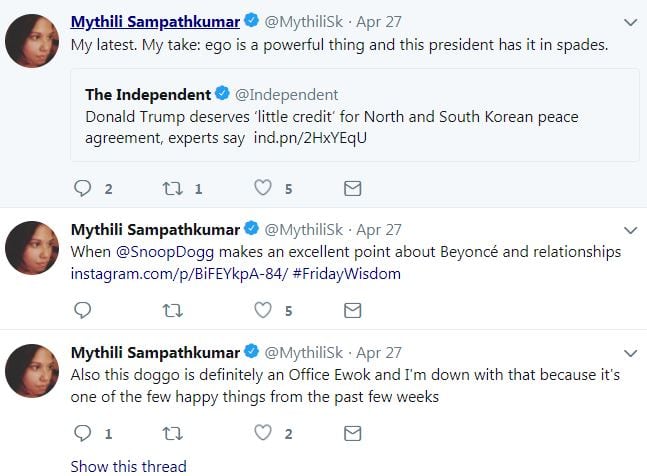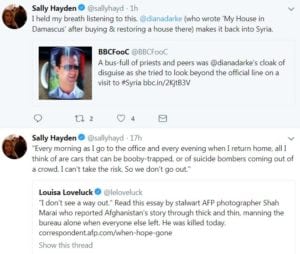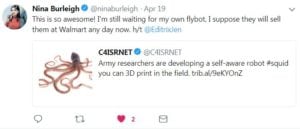
When I joined Twitter in 2009, the platform had begun to take off, but it wasn’t quite essential to a journalist’s work yet. In the nine years since, the platform has grown exponentially, and now it is considered almost a requirement that writers and journalists have Twitter accounts and that they actively participate in conversations happening on the platform.
But as simple as Twitter may seem, it’s not entirely intuitive how journalists should use it. Should it be used as a self-promotion tool? A way to crowdsource stories? A way to engage with readers? A way to have fun? The journalists who are most successful on Twitter use it for all of those things, and move seamlessly between those modes of engagement. So, what can you learn from these journalists?
DO share your stories, but DON’T inundate your followers with only links.
It’s important to share your work with your followers, of course, but you don’t want to only share links. While your followers may click through to read your story or ask questions, if the only things you post are links, eventually, your followers will get bored of you. They can just read your articles online, without following you on Twitter. People want more meaningful engagement from social media.

DO share colleagues’ stories and other interesting links.
On the same thread of engagement, you want to engage with other journalists on the platform, and if there’s something journalists love, it’s having other people share their work. By sharing the work of others, you’re letting your readers discover new sources of information that they can trust, because they already trust you (a huge thing in the age of fake news), and you’re helping your colleagues find a new audience with whom to engage. And, chances are, if you share your colleagues’ stories, they’ll share yours and introduce you to their followers. Again, a brief comment about why you’re sharing the story goes a long way toward encouraging engagement. A short line, such as, “Here’s a unique perspective on X” helps so that your followers aren’t having to guess why you’re sharing the article.

DO respond to followers, but DON’T feed the trolls.
Social media is all about engagement! People want to feel like they have a relationship with you, no matter how small, and they want to have the opportunity to talk with you one-on-one — even if it’s in front of the entire world wide web. So, when someone tweets a question or comment, do your best to reply meaningfully. Answer their questions, “like” their funny comments, thank them for their compliments. If you let followers know that you’re seeing their comments and are willing to engage in some way, you will be rewarded with their loyalty.
Of course, this rule goes out the window if the person trying to engage with you is a troll. You are not obligated or even encouraged to respond to people who are trying to pick a fight with you or get you to blow up (this is affectionately known in the social media world as “feeding the trolls”). There are certainly journalists who push back against these internet monsters, but if you’re genuinely upset by a troll, or feel attacked, the best course of action is to report and block the account and move on with your day. Social media should never take up so much of your energy that you’re thinking about it long after you close out of the app.

DO share insights and thoughts about your beat, even if you don’t have a story to go with it.
Twitter is there 24/7, and it is direct and immediate. When news breaks, it is an opportunity for you to share your expertise. You don’t need to wait until your story hits the next day to share information — tell people what’s happening and why it matters, or share the importance of the moment. If you’re a longtime White House correspondent and the president does something surprising, explain to your followers why that’s so important — or why it’s simply par for the course.
You can also use social media to share more information that wouldn’t necessarily make it into the story. Provide historical context to breaking news, share your behind-the-scenes experience in the course of producing a story, or even share old stories you’ve written to illustrate a point about the current story.

DO share parts of your life and personality, but DON’T feel like you have to share everything.
People not only want to engage with you online, but they want to get to know you. Your followers want to know what kind of person you are and what you’re like when you’re not wearing your journalism cap. So if you want to tweet that ridiculous pun you just thought of, or share a photo of the best bagel you’ve ever had, or tell your followers about your boring Friday night, tweet away — but only if that feels natural to you. Just because you’re online sharing parts of your life doesn’t mean you have to share all of your life. Figure out what makes sense to you to share and set your boundaries. It’s okay to want to keep some moments private. And since you are the one who controls what you post, it’s very easy to keep your life compartmentalized the way you want.
That said, seeing journalists crack jokes or make fun of themselves is something that humanizes us. The brilliant Nina Burleigh, of Newsweek, often visits the area where I grew up, and seeing her tweets about it made me feel comfortable enough to talk to her. I first met the editor of The New York Times’s At War blog, Lauren Katzenberg, because we were tweeting about many of the same things, both in terms of news and irreverent nonsense. And I’ve developed relationships with my readers over the years because I shared parts of my life that spoke to them.


DO use Twitter to crowdsource stories, but DON’T crowdsource every single story.
Twitter connects you to people you’d never encounter in your daily life, and it lets you engage with them in ways you wouldn’t be able to otherwise. As a journalist, that’s an incredible resource, and you should absolutely feel comfortable reaching out to your followers to “pick their brains” for story ideas, anecdotes, information or data points for an article.
However, you should not crowdsource every single story. Your followers want to read your original story angles, research and insights that are a product of your hard work, done the old-fashioned way. Your followers will be happy to help you out occasionally, but not if they feel that you’re taking advantage of them.

DON’T forget to have fun.
The most important thing to remember about Twitter is that it’s just a social media platform. You may not have as many followers as a colleague, or have the engagement numbers you want, but those things don’t make you a better journalist — they just makes you better at Twitter. Twitter should be a tool, and it should be fun. If you find yourself getting stressed out about your personal Twitter account, you should take a step back and think about what would make your use of the platform more meaningful for you. Social media is not one-size-fits-all, so give yourself the space to figure out what will work for you. If you’re being authentic and real, your audience will find you.

Who are your favorite journalists to follow on Twitter? What makes them stand out to you? Tweet me at @EditrixJen and tell me who you think does a great job and who you think other journalists could learn from.

Jennifer Peters is former content manager of the News Media Alliance.

